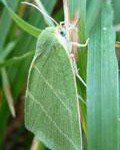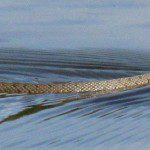NB: The following is reproduced by kind permission of Axe Estuary Birds.
Photos: Greenshank and Redshank chick – Sue Smith; Mediterranean Gull, Small Red-eyed Damselflies, Double Line,
Grey Arches, Lackey, Small Elephant Hawkmoth and Scarce Silver-line – Steve Waite.
Axe Estuary Birds No 136 19th July 2010
Apology
Sorry this edition is a week late, I had computer problems which are hopefully all sorted now.
The Birds
The last period has seen much richer rewards for the local birders, especially during the last week, as wading birds are starting to drop into the valley to have a rest and a re-fuel during their southward migration. Some rough weather (a bit of a rarity this year!) has prompted some sea watches too.
A couple of Green Sandpipers remain in the Colyford Common area, and Common Sandpipers are now also very much passing through at the moment, with eight on 13th the peak count. The first Ringed Plover was noted on 7th, then on 13th a nice over-night arrival included five Little Ringed Plovers (3 adults and 2 juveniles) on Blackhole Marsh along with the ‘autumn’s’ first Dunlin and two Greenshank on Colyford Marsh. The following day a Whimbrel was also here.
Sea watching, as expected at this time of year, wasn’t brilliant. There were still birds to look at though with a few notable sightings. Balearic Shearwaters are regular and annual now in this month, the first lingered off Seaton on 12th, and seven more were seen passing by between then and the end of this period. Manx Shearwaters have been trickling past in small numbers, with 70 west on 25th being the highest count. The only Skuas noted have been Great Skuas, aka Bonxies (the old Shetland name for them, now used world wide!). One flew west on 2nd then three flew past Beer on 14th. A few Common Scoters are passing now too, with some landing and resting offshore.
The first juvenile Yellow-legged Gulls were found on 14th when two were picked out in the flocks of Gulls on the Estuary. Mediterranean Gulls have been fairly frequent within the last couple of weeks, with some cracking summer plumaged adults being seen. Several have also been seen passing, with six passing west within a couple of hours on 2nd.
Two juvenile Peregrines over the river valley on 13th were good to see, and as the Beer pair only raised one young, these must have come from a pair along the Undercliff LNR. Whilst on the subject of locally bred youngsters, the Oystercatcher born on Blackhole Marsh is ‘home and dry’, it is now as big as Mum and Dad. More great news is of the sighting of two Redshank chicks on Colyford Marsh on 13th – though being only a few days old they have a long way to go yet!
Small Red-eyed Damselflies are out again at Lower Bruckland Pond, and are best seen in areas with plenty of floating weed/vegetation. Although the most recent weather hasn’t been any good for moths, there was some good weather towards the start of the period. Here’s a few of the highlights from my moth trap…
Photos: Greenshank and Redshank chick – Sue Smith; Mediterranean Gull, Small Red-eyed Damselflies, Double Line,
Grey Arches, Lackey, Small Elephant Hawkmoth and Scarce Silver-line – Steve Waite.
The Trivia
On a walk from Colyford to Colyton along the Coly on 17th Moira Anderson saw the Kingfisher flying up and down the river, she was not sure if it was the same one or several! Also in a little glade half way along the Coly side between the A3052 and the Mill she saw a Tree Creeper and 2 Spotted Flycatchers busy doing just as their names suggests!!! Also saw a couple of Comma butterflies.
David was at Bowling Green Marsh recently and shared the hide with a large, lethargic tabby cat. Like David, perhaps he was not too old to admire the birds, but too old to do anything about it!
News from Holyford Woods
Over the last four weeks, the Woods have gradually slipped into summer mode. The bracken is over 6ft. in places, the ferns have done really well and several Stink-horns have tainted the air with their ‘aroma’. In open places and on The Hangings the brambles have taken over. There will be a very good crop of blackberries if the weather behaves! The long dry spell has meant few wild flowers along the path below The Hangings, but butterflies have been busy in other areas. I have seen 5 Orange Tips, 6 Green-veined Whites, 2 Holly Blues, several Peacocks, Red Admirals, Speckled Woods, Meadow Browns, 1 Small Tortoiseshell and 1 Comma. The occasional Hornet has been seen too.
Among birds heard and/or seen are Song Thrush, Blackcap, Chiffchaff, Greater Spotted Woodpecker, and 2 Bullfinch and I have watched a Tree Creeper and a Nuthatch feeding young in oak trees. The dense greenery renders binoculars almost useless. There has been a second family of Moorhens but Top Pool is so overgrown a count is impossible. Here there are some magnificent Jurassic (or are they Triassic?) Giant Horsetail lining the stream.
The Roe Deer have not been in the Woods very much, but I have seen females grazing in the fields both North and South of the valley, with their young out of sight, but yesterday Paco told me there was deer about, and on going in to the undergrowth he disturbed a young one and mother. Their reaction was too swift for a photograph. Paco has ignored the Badger Setts so all is quiet there, but Squirrels get chased up trees – yesterday I got a shower as one raced through the wet leaves above me. The world is in a mess, but Holyford is always a wonderful place to escape to.
Ringing
Monday 19th’s session resulted in 39 birds of which two were retraps. The tally was:
Mute Swan (1) plus 3 cygnets too small to ring; Chiffchaff 2; Blue Tit 7; Reed Warbler 17(1); Greenfinch 4; Goldfinch 3; Kingfisher 1; Sedge Warbler 1; Reed Bunting 2; and Wren 1.
Diary Dates
Every Tuesday, Thursday and Saturday from 10.00 a.m. to 4.00 p.m. Biodiversity Exhibition at the old TIC in Seaton’s Underfleet Carpark, with various informal walks and talks – more details at the Exhibition or phone 01395 517557.
This twice-monthly email newsletter is freely available to anyone who would like it, as is a periodic one about the activities of the East Devon Local Group of the Devon Wildlife Trust. Just send me an email with Axe Estuary Birds and/or East Devon DWT in the subject line. Also, for those without a computer, I will send a copy by post if you would like to send me some stamps.
Thanks to those who keep us informed – please continue to tell us of any unusual, interesting or amusing sightings, and what is about locally, and send any photos you would like to share.
Steve, Mike, Jean and David.
davidwalters@eclipse.co.uk. tel. 01297 552616 Mobile 0779 1541 744.
7 Springfields, Colyford, Colyton, EX24 6R
Grass Snake in the Borrow Pit 9th July 2010 – photo Sue Smith










